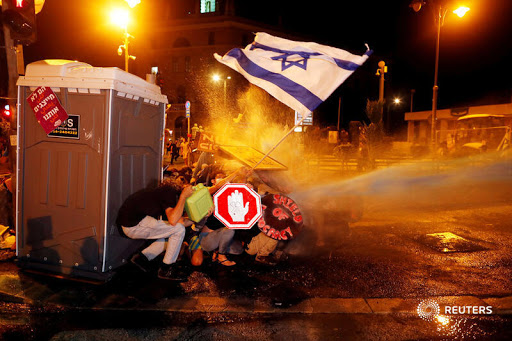A combination picture
shows Kenyan fashionista James Maina Mwangi posing as he displays his attire
comprising at least 160 suits with matching accessories including a mask to
prevent the coronavirus disease (COVID-19) infection at his residence in
Nairobi, Kenya July 30, 2020. REUTERS/Thomas Mukoya
What you mainly get a
sense from in Mohamed al-Sayaghi’s picture is
the weight of the sheep being carried away. It’s probably wriggling about quite
a bit, making it even harder to carry. The image has been shot quite wide so
you get a real feeling of the bustle of the ancient business of goat-selling, with
straw, and mud all mingled in with the modern trappings of cars, a modern
building with reflective glass and advertising hoardings as people prepare for
the festival.
A man carries a
sheep at a livestock market ahead of the Eid al-Adha festival amid the
coronavirus disease (COVID-19) pandemic in Sanaa, Yemen July 28, 2020. REUTERS/Mohamed
al-Sayaghi
In Ronen Zvulun’s picture your attention is
immediately grabbed by the graphic shape of the hand contrasting with the the red
and the Israeli flag. It takes more than a little while before you can visually
get around this bold and loud shape to see the water cannon spray thundering
into the crouching protesters, who protect themselves with small shields. Read
on here.
Police use water
cannon during a protest against Israeli Prime Minister Benjamin Netanyahu's
alleged corruption and his government's handling of the coronavirus disease
(COVID-19) crisis, near his residence in Jerusalem July 26, 2020. REUTERS/Ronen
Zvulun
Makeshift roofing,
rubbish in the street and drying clothing hanging over rough brick walls
crisscross through Khaled Abdullah’s picture and dwarf the two figures. This
feeling of enormity echoes the seemingly insurmountable problem of poverty and
poor housing. Everything crushes down heavily in the heat and squalor: the old
tyres, the large bricks, the makeshift weights to keep the flimsy roofs from
blowing away.
Boys play at a slum area for the Muhamasheen (marginalized) community in
Sanaa, Yemen July 26, 2020. REUTERS/Khaled
Abdullah
Although this is a straightforward before
and after image using Ahmed Jadallah’s file picture dated 2016, the power of comparison to demonstrate the
impact of COVID-19 and social distancing
is striking. Read on here.
A combination
picture shows Muslim pilgrims circling the Kaaba at the Grand mosque during the
annual Haj pilgrimage September 8, 2016, and after the coronavirus disease
(COVID-19) outbreak July 29, 2020, in Mecca, Saudi Arabia. Pictures taken
September 8, 2016 and July 29, 2020. REUTERS/Ahmed Jadallah (top)/ Saudi
Ministry of Media/Handout via REUTERS
What a wonderful
feature picture by Zohra Bensemra who teases us with “photography pure”
elements of the moment caught, tones, shape and colour. Take the time to get
past the almost abstract shapes and tones of solid blacks that fill the
foreground. We are given just enough highlight detail of the boy’s face in the
centre, but nothing is given away in the figure on the left or the dark space
on the ground, we just have to figure it out ourselves. To counter these
shadows we are treated to the full orange colour in bright sunlight of the boy
playing, legs at full stride, head held high, a moment caught. I even like the
roof of the building that just kisses the edge of the frame against the blue
sky.
Children are seen
at the fishermen port ahead of the Muslim festival of sacrifice Eid al-Adha,
amid the coronavirus disease (COVID-19) outbreak, in Dakar, Senegal July
30,2020. REUTERS/Zohra Bensemra
The dawn light bursts over a herd of goats
being sold off for slaughter in Thomas Mukoya’s picture. The image is well
composed so the animals’ bodies fan out from the centre highlight of the sun,
like rays of warmth reaching out to the chill in the foreground. Dotted amongst
them are herders and customers alike drawing us deeper into the picture as the
goods are inspected and haggled over.
Muslim faithful
buy goats at a livestock market during celebrations marking the Muslim holiday
of Eid al-Adha amid the spread of the coronavirus disease (COVID-19) in
Nairobi, Kenya July 31, 2020. REUTERS/Thomas Mukoya
I can’t hide my pleasure over a great
detail picture that focuses on a small element of a scene that tells a bigger
story, and this enjoyment is doubled when it’s an element from a hard to
illustrate economic story. Afolabi Sotunde has captured a money dealer flicking
through naira notes that are as tired and worn as the trader’s fingers. The story
is that the economy is struggling as businesses struggle to find U.S. dollars
to buy the materials they need to continue trading. The oil price, Nigeria’s
main export to secure dollars, is depressed by the impact of COVID-19. Read on here.
A man carries
Nigerian naira banknotes at a livestock market in Abuja, Nigeria July 29, 2020.
REUTERS/Afolabi Sotunde








No comments:
Post a Comment